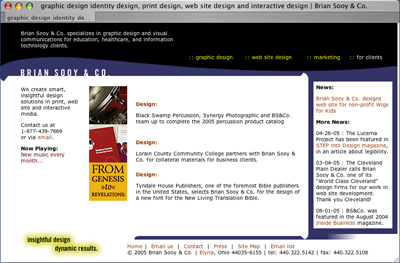Three Faces of Self-Promotion

Self-promotion — ugh. It means pasting a fake smile on your face as you network at cocktail parties, or wasting piles of money on eye candy that recipients toss in the trash seconds after opening the package.
Right?
Not according to the three creative professionals I interviewed. They’re all successes, but they all veer from conventional promotion technques in one way or another.
Brian Sooy, Designer
Brian Sooy is a graphic designer, Web designer, type designer, and principal of a four-person firm, Brian Sooy and Company.
Brian doesn’t follow the traditional promotion path. "I take a different tack than most design firms. The only marketing brochure I have is a 4 by 9 two-panel thing that’s totally out of date."
Instead, Brian gets new business by focusing on what potential clients need. He occasionally sends short e-mail newsletters to a select list of current and former customers. "It emphasizes things other than our firm, but it does show the business community that design really makes a difference. For example, one newsletter was about the iPod and how it’s done so well because it’s well-designed. And each issue highlights late-breaking news about a client, like awards they’ve gotten. It’s scratching their backs instead of our own, which changes their perception of us. Then I throw in a few things about our company. It’s soft selling."
Brian notes that the email newsletter alone isn’t enough. "Some clients are so busy that they barely skim it. So we reinforce information like new hires by printing and sending postcards to people we really want to work with."
Even the company’s Web site is geared toward the needs of the business community. "Seven out of ten Web site designers use Macromedia Flash," Brian says. "But Flash is the kiss of death for search engines, so we don’t use it on our site or our clients’ sites."
He also tries to reach possible clients by getting his name in the publications they’re likely to read. As an example, he cites a font he designed for a bible printed by Tyndale House Publishers. "I started putting out the word to the media. An article in a regional business magazine turned into a front-page mention in the local paper. Then the Associated Press picked up the news, and it went national. People see articles like that and contact us."
Brian finds that his best promotion tool doesn’t require email, postcards, or news articles. "Word of mouth is very effective. So part of the process is just finding people who like the firm or me. I don’t mean you have to be best friends, but don’t be afraid to create a connection with someone. You’ll make the business relationship work long-term. I believe in doing business honestly and treating people fairly. And that’s paid back. So even the way you do business is a form of self-promotion. It’s sort of a holistic thing."
John Chapple, Photographer
"I was 16 and in a job I didn’t like doing," says John Chapple, a New York-based freelance photographer who shoots news and features mostly for British newspapers, including the Times of London.
"One day I was on the train to work, and I just got off. I knew I wanted to be a photographer, so I went to the local newspaper and asked the girls behind the subscription desk how to get into photography. They obviously didn’t have anything helpful to say — they just told me what they’d tell any spotty 16-year-old asking for a job. Now I’m starting to panic because I’ve put my job at risk by stepping off the train. So I walk into a wedding photographer’s studio, but I was so nervous that instead of asking them how to get into the industry, I asked for a job. They said to come back next month, and then they hired me as a general dogsbody."
How John rose from wedding studio grunt to an international photographer who shoots everyone and everything — from a Brooklyn street gang to a Chihuahua wearing a dress to Shirley MacLaine — is a classic self-made-man story. It turns out that the owner of the wedding studio also owned a local press agency. When he saw the press shots John shot in his free time, the owner gave John a job as a photographer with the agency. His pictures appeared first in local papers, then regional, then national.
Although John is too humble to say so, it’s obvious that he wouldn’t have progressed so far unless his photographs were of the highest quality. Yet he says the most important thing he can do to assure more assignments is to be "good fun on the road. This job means being on the road half the time and at home half the time. As long as you have a good laugh with the reporter on the road, they’ll call you again. You can’t be a pain in the ass and make ridiculous demands."
"It has always been said on Fleet Street that the best stories get assigned down the pub," John notes, "and hanging out where the best writers hang out is obviously a good way to get work. But as a photojournalist working overseas, you have to be a bit more versatile. I qualified as a scuba diver so I could branch out into underwater photography. But then I discovered that the correspondents for some of the biggest UK papers are also into doing a bit of diving. So on jobs in Florida or the Caribbean we started doing the odd dive in between shoots and before you know it I am the photographer of choice for all jobs near a good dive location. You have to be smart about fitting in and mixing business with pleasure."
Karima Cammell, Illustrator/Printer/Retailer
The phrase "castle in the air" usually describes a daydream that’s divorced from reality. For Karima Cammell, it’s the name of a very real business that she’s built painstakingly over several years.
I came across Karima’s work while looking through samples printed by Creativepro.com’s parent company, PrintingForLess.com. The sample that caught my eye was an illustrator’s mini-portfolio. Its watercolors depicted an unusual world, where panthers wear emerald rings and a woman dressed for a day in the city pauses thoughtfully in front of a circus elephant.
When I called Karima to interview her for this article, I found that although illustration is just one small part of her business, her vision extends to everything she does, and every interaction she has with potential customers.
Castle In the Air is Karima’s shop in Berkeley, California, that carries an eclectic mix of wares, including art books, vintage art materials, and handmade stationery. "I’m an artist catering to artists," Karima says.

Everything about Castle In the Air, from the Web page you see here to the store’s contents, carries out Karima Cammell’s dreamy vision.
Castle In the Air is also a school, with classes that often use materials you can buy in the store, such as crepe paper imported from Germany. "We don’t make much money on classes — it’s about spreading the culture of the store." Karima has found that direct-mail pieces are the most effective promotion tool for the school.
Castle In the Air’s third face is "a studio for the imagination," which specializes in custom printing and illustration. "We do a ton of custom printing, from large all-letterpress weddings to smaller offset jobs," Karima explains. "I never put my name on anything, not even postcards, but enough people ask who did the work that the word of mouth ends up being pretty huge. Think about wedding invitations: 100 to 300 people receive samples of your work! Once you open the door to custom printing, it is its own advertisement."
Karima cautions anyone who thinks they can get rich following her footsteps that Castle In the Air is "not very lucrative." Nevertheless, her position is enviable. " I’m believing in a fantasy and I’m making it real. I’ve created a lifestyle and culture that are wonderful."
Now It’s Your Turn
Brian, John, and Karima all demonstrate that self-promotion need not include phoney networking or showy gifts. What has worked for them can work for you, no matter what your situation. Their successful tactics include the following:
- Be true to yourself and your dreams.
- Make the most of your strengths, whether they’re a sense of humor or an out-of-the-ordinary vision.
- Don’t be afraid to start small.
- Pat the customer’s back first.
- Remember that referrals can come from anywhere. Any interaction you have can result in good word of mouth, or bad word of mouth. It’s up to you.
This article was last modified on December 17, 2022
This article was first published on May 27, 2005
Commenting is easier and faster when you're logged in!Loading comments...





